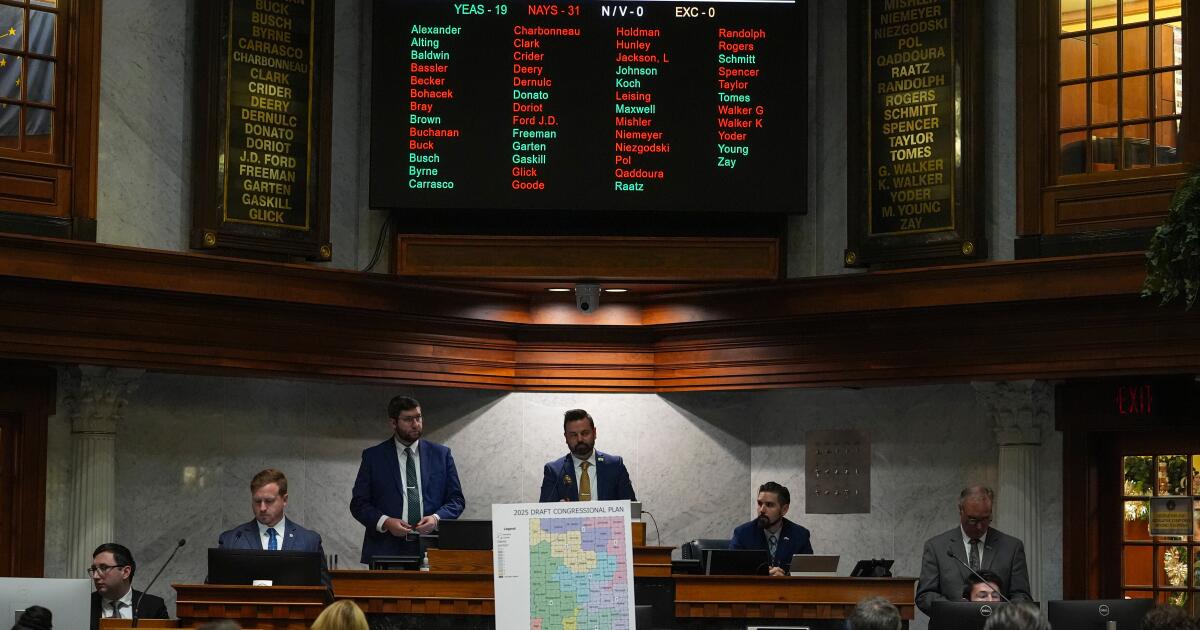INDIANAPOLIS — Indiana’s Republican-led Senate decisively rejected a redrawn congressional map Thursday that would have favored their party, defying months of pressure from President Trump and delivering a stark setback to the White House ahead of next year’s midterm elections.
The vote was overwhelmingly against the proposed redistricting, with more Republicans opposing than supporting the measure, signaling the limits of Trump’s influence even in one of the country’s most conservative states.
Trump has been urging Republicans nationwide to gerrymander their congressional maps in an unprecedented campaign to help the party maintain its thin majority in the House of Representatives. Although Texas, Missouri, Ohio and North Carolina went along, Indiana did not — despite cajoling and insults from the president and the possibility of primary challenges.
“The federal government should not dictate by threat or other means what should happen in our states,” said Spencer Deery, one of the Republican senators who voted no Thursday.
When the proposal failed, 31 to 19, cheers could be heard inside the chamber as well as shouts of “thank you!” The debate had been shadowed by the possibility of violence, and some lawmakers have received threats aimed at persuading them to support the proposal.
Trump tried to brush off the defeat, telling reporters in the Oval Office that he “wasn’t working on it very hard” despite his personal involvement in the pressure campaign.
Two Democratic districts targeted
The proposed map was designed to give Republicans control of all nine of Indiana’s congressional seats, up from the seven they currently hold. It would have essentially erased Indiana’s two Democratic-held districts — splitting Indianapolis among four districts that extend into rural areas, reshaping U.S. Rep. André Carson’s safe district in the city and eliminating the northwest Indiana district held by U.S. Rep. Frank J. Mrvan.
District boundaries are usually adjusted once a decade after a new census. But Trump has cast the issue in existential terms for his party as Democrats push to regain power in Washington.
“If Republicans will not do what is necessary to save our Country, they will eventually lose everything to the Democrats,” Trump wrote on social media the night before the vote.
The president said anyone who voted against the plan should lose their seats. Half of Indiana senators are up for reelection next year, and the conservative organization Turning Point Action had pledged to fund campaigns against them.
David McIntosh, president of Club for Growth, which had backed redistricting, said the vote allowed disloyal Republicans to “stick their finger in the eye of the president of the United States.”
Former Indiana Gov. Mitch Daniels praised the senators for “courageous principled leadership” in rejecting the new map.
A Republican who has vocally criticized Trump, Daniels said the outcome was “a major black eye for him and all the Washington groups that piled in, spent money, blustered and threatened.” He added that “this thing rubbed our state the wrong way and Republicans in our state very wrong from the jump.”
‘A full-court press’
Inside the state Senate chamber, Democratic lawmakers spoke out against redistricting ahead of the vote.
“Competition is healthy, my friends,” Sen. Fady Qaddoura said. “Any political party on Earth that cannot run and win based on the merits of its ideas is unworthy of governing.”
In the hallways outside, redistricting opponents chanted “Vote no!” and “Fair maps!” while holding signs with slogans such as “Losers cheat.”
Three times over the fall, Vice President JD Vance met with Republican senators — twice in Indianapolis and once in the White House — to urge their support. Trump joined a conference call with senators on Oct. 17 to make his own 15-minute pitch.
Behind the scenes, James Blair, Trump’s deputy White House chief of staff for political affairs, was in regular touch with members, as were other groups supporting the effort such as the Heritage Foundation and Turning Point USA.
“The administration made a full-court press,” said Republican Sen. Andy Zay, who said he was on the phone with White House aides sometimes multiple times per week, despite his commitment as a yes vote.
Across the country, mid-cycle redistricting so far has resulted in nine more congressional seats that Republicans believe they can win and six more congressional seats that Democrats think they can win — five in California. Some of the new maps, however, are facing litigation.
In Utah, a judge imposed new districts that could allow Democrats to win a seat, saying Republican lawmakers violated voter-backed standards against gerrymandering.
Republicans were split over plan
Despite Trump’s push, support for gerrymandering in Indiana’s Senate was uncertain. A dozen of the 50 senators had not publicly committed to a stance ahead of the vote.
Republican Sen. Greg Goode signaled his displeasure with the redistricting plan before voting no. He said some of his constituents objected to seeing their county split up or paired with Indianapolis. He expressed “love” for Trump but criticized what he called “over-the-top pressure” from inside and outside the state.
Sen. Michael Young, another Republican, said the stakes in Washington justify redistricting, as Democrats are only a few seats away from flipping control of the U.S. House in 2026. “I know this election is going to be very close,” he said.
Republican Sen. Mike Gaskill, the redistricting legislation’s sponsor, showed senators maps of congressional districts around the country, including several focused on Democratic-held seats in New England and Illinois. He argued that other states gerrymander and that Indiana Republicans should therefore play by the same rules.
The bill cleared its first hurdle Monday with a 6-3 Senate committee vote, although one Republican joined Democrats in opposing it and a few others signaled they might vote against the final version. The state House passed the proposal last week, with 12 Republicans siding with Democrats in opposition.
Among them was state Rep. Ed Clere, who said state troopers responded to a hoax message claiming there was a pipe bomb outside his home Wednesday evening. Indiana state police said “numerous others” received threats but wouldn’t offer details about an ongoing investigation.
In an interview, Clere said these threats were the inevitable result of Trump’s pressure campaign and a “winner-take-all mentality.”
“Words have consequences,” Clere said.
Volmert, Lamy and Beaumont write for the Associated Press and reported from Lansing, Mich., Indianapolis and Des Moines, respectively.


















